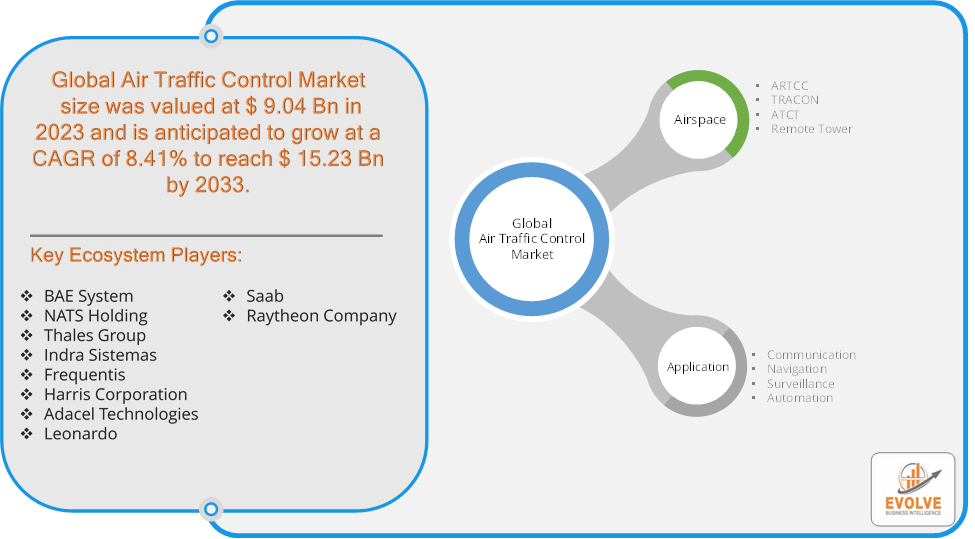Air Traffic Control Market Grows: 8.41% CAGR

Evolve Business Intelligence has published a research report on the Global Air Traffic Control Market, 2023–2033. The global Air Traffic Control Market is projected to exhibit a CAGR of around 8.41% during the forecast period of 2023 to 2033.
Evolve Business Intelligence has recognized the following companies as the key players in the global Air Traffic Control Market: BAE System, NATS Holding, Thales Group, Indra Sistemas, Frequentis, Harris Corporation, Adacel Technologies, Leonardo, Saab and Raytheon Company.
 More Information: https://evolvebi.com/report/air-traffic-control-market-analysis/
More Information: https://evolvebi.com/report/air-traffic-control-market-analysis/
Market Highlights
The Global Air Traffic Control Market is projected to be valued at USD 15.23 Billion by 2033, recording a CAGR of around 8.41% during the forecast period. The Air Traffic Control (ATC) Market encompasses the systems, technologies, and services used to manage and control air traffic. This market includes various components such as communication systems, navigation systems, surveillance systems, and automation systems, all of which are essential for ensuring the safe and efficient movement of aircraft within controlled airspace and on the ground.
The Air Traffic Control Market plays a crucial role in the aviation industry, ensuring the safety and efficiency of air travel. The market continues to evolve with technological advancements and increasing demand for air transportation.
The COVID-19 pandemic had a significant impact on the Air Traffic Control (ATC) Market. The pandemic led to a sharp decline in air travel due to travel restrictions, lockdowns, and a decrease in passenger demand. This resulted in significantly reduced air traffic volumes, affecting the demand for ATC services. Airlines and airports faced severe financial challenges due to the drop in passenger numbers and revenues. This financial strain led to delays or cancellations of planned investments in ATC infrastructure and technology upgrades. Air traffic controllers and ATC service providers had to adapt to new operational procedures to ensure safety and social distancing, including changes in shift patterns and remote working arrangements where possible. The pandemic highlighted the need for greater automation in ATC systems to maintain efficiency and safety with reduced human intervention. This has accelerated the adoption of automation and digitalization in ATC operations. With the reduced traffic, some airports and ATC service providers shifted their focus to maintenance, training, and upgrading existing systems rather than investing in new infrastructure. The pandemic has led to the implementation of new health and safety protocols within ATC facilities to protect the workforce, which may have long-term implications for how ATC operations are managed.
Segmental Analysis
The global Air Traffic Control Market has been segmented based on Airspace and Application.
Based on Airspace, the Air Traffic Control Market is segmented into ARTCC, TRACON, ATCT and Remote Tower. The ARTCC segment is anticipated to dominate the market.
Based on Application, the global Air Traffic Control Market has been divided into Communication, Navigation, Surveillance and Automation. The Communication segment is anticipated to dominate the market.
More Information: https://evolvebi.com/report/air-traffic-control-market-analysis/
Regional Analysis
The Air Traffic Control Market is divided into five regions: North America, Europe, Asia-Pacific, South America, and the Middle East, & Africa. North America, particularly the United States, has some of the most advanced ATC infrastructure, driven by the Next Generation Air Transportation System (NextGen) initiative. The region handles a significant volume of both domestic and international flights, necessitating robust ATC systems. In Europe region, The Single European Sky (SES) initiative aims to unify and modernize Europe’s fragmented airspace. Europe experiences dense air traffic, particularly in major hubs like London, Paris, and Frankfurt and strong emphasis on reducing emissions and noise pollution. The Asia-Pacific is experiencing rapid growth in air travel due to economic development, increasing disposable incomes, and urbanization. Significant investments in new airport construction and ATC infrastructure modernization and adoption of new technologies like remote towers and automated systems in rapidly developing markets. The Middle East serves as a strategic transit hub connecting Asia, Europe, and Africa and Governments in the region, particularly in the UAE and Qatar, are investing heavily in aviation infrastructure. Latin America region is characterized by varying levels of ATC development, with some countries having advanced systems while others face challenges in infrastructure and technology.
